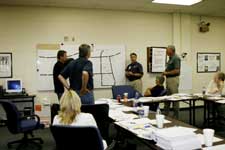Program YY (P3/HOT)
Course Names
Pandemic Planning and Preparedness (P3);
Hands-On Training for CBRNE Incidents (HOT)
Target Audience/Disciplines
Course Descriptions
The Pandemic Planning and Preparedness course is a three-day course that provides the planning and management level responders the tools necessary to assemble an effective pandemic planning and preparedness program. The course culminates in a practical exercise that casts students in various government roles where they must participate in planning and responding to a pandemic.
Below are some, but not all, of the critical skill sets learned during this training program
- Determine the response actions of various response disciplines as they relate to crisis communications, contact management, isolation, infection control, social distancing, travel restrictions, and quarantine
- Distinguish the possibilities for rapidly expanding the capacity of the existing healthcare system in order to provide triage and medical care
- Determine fatality management and palliative care requirements to ensure proper handling of the expectant and dead resulting from a pandemic event at its peak
- Put into operation a pandemic plan to determine the severity of the pandemic, to initiate appropriate mitigating and response actions, and to ensure the viability of the jurisdiction
Hands-On Training for CBRNE Incidents (HOT) is a two-day course which affords participants the opportunity to develop and apply CBRNE incident response practices in a realistic training environment. HOT provides responders the unique opportunity to practice their knowledge and skills in the world’s only toxic chemical, biological, radiological training facility dedicated solely to emergency responders—the Chemical, Ordnance, Biological, and Radiological Training Facility (COBRATF).
Below are some, but not all, of the critical skill sets learned during this training program:
- Operate chemical, biological, and radiological detection equipment
- Identify types of dissemination devices, including direct deposit, breaking, spraying, bursting/exploding, and vector
- Describe/classify explosive materials by type of explosion, sensitivity, and effects of the blast
- Perform triage of mass casualties and support the evacuation of victims through the introduction of definitive medical care
- Conduct mass and technical decontamination operations while wearing personal protective equipment (PPE)
Additional Qualifications/Certifications
- IS-100.b: Introduction to Incident Command System (ICS) or any of the available IS-100 versions
- IS-200.b: ICS for Single Resources and Initial Action Incidents or any of the available IS-200 versions
- IS-700.a: National Incident Management System (NIMS), An Introduction or any of the available IS-700 versions
- IS-800.b: National Response Framework (NRF), an Introduction or any of the available IS-800 versions
- Awareness training for Chemical, Biological, Radiological, Nuclear, or Explosive (CBRNE) response through AWR-160 Standardized Awareness Authorized Training or another equivalent certified training program
Course Lengths
Course Codes
CEUs
- International Association for Continuing Education and Training (IACET): 2.4
- Nursing, through Alabama Board of Nursing (nurses only): 24
- Continuing Medical Education, through University of Alabama at Birmingham (additional allied health professionals may be able to apply for these CMEs): 24
- CA Environmental Health Specialist, through National Environmental Health Association (environmental health professionals): 24
- Police Officer Standards and Training (POST; approved per state): 24
- International Association for Continuing Education and Training (IACET): 1.6
- Nursing, through Alabama Board of Nursing (nurses only): 16
- Police Officer Standards and Training (POST; approved per state): 16

